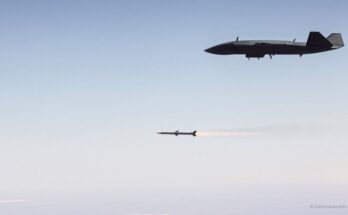More Nations Showing Interest in Lockheed’s Fifth-Generation Fighter as Headwinds Emerge in Switzerland and the United Kingdom
by J. Kasper Oestergaard, European Correspondent, Forecast International.

Recently, the Finnish Ministry of Defense announced its selection of the Lockheed Martin F-35 as a replacement platform for the Finnish Air Force fleet of 62 F/A-18C/D Hornets. The Finns will procure 64 F-35A Block 4 aircraft, with deliveries commencing in 2026. Despite concerns about sustainment costs, a topic that has been heavily debated in the U.S., Lockheed Martin’s business development team has been successful in winning nearly every fighter competition where the F-35 has been a contender. The only upset was in early 2019, when Germany rejected the F-35 and decided to proceed with the Eurofighter Typhoon and Boeing’s F/A-18 Super Hornet as replacement platforms for its Tornado fleet. With the HX fighter competition in Finland now in the rear-view mirror, it is reasonable to ask: What is next for the F-35 in Europe? And what nations are next in line to acquire the fifth-generation fighter?
A number of European countries have expressed significant interest in acquiring the F-35, including the Czech Republic, Greece and Spain, and sales campaigns in these nations are ongoing.
The Czech Republic is looking to acquire new fighters, and some speculate that Prague may view the F-35 as simply too expensive given the nation’s relatively limited budgets. Some sources mention a requirement for as many as 40 aircraft, which seems a bit high for a nation currently operating a much smaller fleet. The Czechs currently have 12 JAS 39C and two JAS 39D Gripens on leases that expire in 2027 but include two-year extension options. The two main bidders for new Czech fighters are Saab, which is offering 24 of either its JAS 39C/D or newest JAS 39E/F models, and Lockheed Martin, which is offering 18 F-16V Block 70/72s or F-35As. In 2018, neighboring Slovakia opted to buy 14 F-16V Block 70 jets, with delivery scheduled for the mid-2020s. A Czech decision on new fighters is expected to be several years away.
At the beginning of 2021, Greece was operating a fleet of 33 F-4s, 153 F-16s, and 40 Dassault Mirage 2000 fighter jets. Athens is currently considering the possibility of acquiring a number of F-35s to replace its oldest F-16s. Quantities of up to 40 aircraft have been mentioned by different sources. Greece has also indicated an interest in taking delivery of secondhand F-35As, but the U.S. has pushed back on that. The U.S. ambassador to Greece, Geoffrey Pyatt, has stated that F-35s cannot be delivered to Greece before an appropriate infrastructure has been established to store and maintain the fighter jets in-country. It is believed it will take at least five years to develop this infrastructure. According to the Hellenic Air Force, the oldest F-16s in its fleet are 70 F-16C/D Block 30/50 models purchased in 1985 (Block 30 models delivered 1989-90) and 1993 (Block 50 models delivered 1997-98). Greece is currently upgrading its fleet of 84 F-16C/D Block 52+ aircraft to the F-16V Block 72 configuration. In January 2021, Greece signed a deal with France to acquire 18 Dassault Rafale fighters (six new-build aircraft and 12 secondhand units) to replace its oldest Dassault Mirage 2000s. In September, Greece added another six aircraft, increasing the total Rafale commitment to 24 jets. The first Rafale was delivered to Greece in July 2021. The Rafale is also a potential replacement platform for Greece’s F-4 fleet. Athens is reportedly also considering the acquisition of 30 secondhand Royal Air Force (RAF) Eurofighter Typhoons to replace the aging F-4. It is at this time uncertain when the Greeks will make a decision on the F-35.
In Spain, two opportunities exist for the F-35. The first opportunity is a requirement for fighters to replace the Spanish Air Force fleet of 72 EF-18 Hornets, and the second is a requirement to replace 12 McDonnell Douglas EAV-8B Matador II+ jets (EAV-8B is the name for the AV-8B Harrier used in Spain) operating from the amphibious assault ship Juan Carlos I.
The EF-18 replacement opportunity features two separate efforts. The first and more immediate effort involves the 20 oldest aircraft, currently based in the Canary Islands. These will most likely be replaced on a one-for-one basis by the Eurofighter Typhoon. The second effort seeks to replace the main EF-18 fleet operating out of the Zaragoza and Torrejón air bases. The F-35A and Eurofighter are both being considered for this effort. However, Spain’s position as an Airbus nation will likely heavily influence both the process and final decision. One should keep in mind that it is still early days for the EF-18 replacement efforts. Spain’s procurement office is just beginning the aircraft feasibility studies, and the wider fleet is scheduled to remain in service until at least 2030.
As the only VTOL/STOVL fighter on the market, the F-35B seems set to win the EAV-8B replacement effort when the Spanish Navy retires the jets in the early 2030s. Commissioned in 2010, the Juan Carlos I is a relatively new vessel, and there are currently no plans to decommission the carrier. Spain is currently sending mixed signals and is sensitive to flirting with an American product at a time when it is working to establish itself as an equal partner with Germany and France on the Future Combat Air System (FCAS) program. Just recently, a Defense Ministry spokeswoman informed Reuters that Spain has no interest in the F-35 and is solely committed to FCAS. Lockheed Martin has confirmed that F-35 discussions with Spain are in the preliminary stages and have not yet progressed into classified briefings.
Beyond new European nations looking to join the F-35 ranks, all eyes will be on the United Kingdom, which will, in the coming years, decide whether or not to order more F-35Bs for the Royal Air Force and Royal Navy. At this time, only 48 out of the 138 U.K. F-35Bs in the official program of record are firm orders. The last of the initial batch of 48 aircraft will be delivered in 2025. While it appears unrealistic that the United Kingdom will commit to buying the originally planned quantity of 138 F-35Bs – especially given the level of ambition and emphasis being signaled on the Tempest program – it is believed that more aircraft will be ordered. Justin Bronk, an air warfare expert at the Royal United Services Institute, earlier this year stated that the highest plausible F-35 purchase is now in the region of 60-72 jets. If the British F-35 buy is capped somewhere in this range, it means that 66-78 F-35Bs would be removed from the official program of record. Air Marshal Richard Knighton, the Deputy Chief of Defence Staff for Financial and Military Capability, stated in December 2020 that he expects to see a definitive decision on the total future F-35 fleet in the 2025 timeframe. In early 2021, the First Sea Lord and Chief of the Naval Staff, Sir Tony Radakin, stated that the F-35 order would be upped to 60 aircraft, then maybe up to around 80 for four deployable squadrons. As of November 2021, 24 F-35Bs had been delivered to the U.K. Six more jets will arrive in 2022, followed by another seven in 2023. All of the 48 in the first batch will have been delivered by the end of 2025.
Also, while Switzerland officially selected the F-35 this summer, there is still widespread opposition to the purchase in the Alpine nation. The initial decision to acquire a new fighter jet was only approved by a razor-thin margin in a public referendum. The anti-F-35 movement is seeking to gather 100,000 signatures, which is the number needed to initiate a new vote on the fighter acquisition. It will likely be successful in obtaining these. However, overturning the F-35 selection is more difficult, as Swiss law requires a “double majority.” This means that a majority of voters as well as a majority of cantons must vote to overturn the acquisition. In November, a Swiss parliamentary committee announced that it would probe the government’s decision. A subcommittee will start work in February 2022 and subsequently publish its findings. This is not the first time that Switzerland is witnessing strong internal opposition to a fighter jet acquisition. A decade ago, Saab’s JAS 39 Gripen was selected to replace the aging Swiss fleet of F-5s, but in 2014, the process was halted by a referendum. Swiss voters rejected the deal and the contract was subsequently canceled. Switzerland expects to procure a total of 36 F-35As.
While the F-35 has been very successful in securing European sales, headwinds do exist. With the U.K. potentially looking to significantly reduce its planned F-35 buy, Finland’s decision to acquire the aircraft was indeed very welcome news.
References:
- https://fidsmprod.wpengine.com/2021/12/10/finland-taps-f-35-lightning-ii-to-replace-hornet-jet-fighter-inventory/
- https://fidsmprod.wpengine.com/2019/04/17/greece-contemplates-f-35-acquisition-to-replace-oldest-f-16s/
- https://www.forecastinternational.com/news/index.cfm?recno=280716
- https://eurasiantimes.com/why-germany-rejected-stealth-f-35-jets-opted-for-eurofighter-typhoons/
- https://eurasiantimes.com/germany-approves-nuclear-capable-f-a-18-super-hornets-ew-aircraft-ea-18g-growlers-to-modernize-fleet-media/
- https://eurasiantimes.com/after-saab-gripen-why-switzerland-could-undo-its-6-5b-f-35-stealth-fighter-jet-deal-with-the-us/
- https://www.reuters.com/article/us-swiss-vote-gripen-idUSBREA4H05920140518
- https://www.dassault-aviation.com/en/group/press/press-kits/dassault-aviation-delivers-its-first-rafale-to-greece/
- https://www.ainonline.com/aviation-news/defense/2021-01-21/first-upgraded-f-16v-fighter-greece-takes-flight
- https://www.aviacionline.com/2021/09/confirmed-greece-buys-six-more-dassault-rafale/
- https://www.aerotime.aero/29315-greece-considers-raf-eurofighter-typhoons
- https://www.janes.com/defence-news/news-detail/f-35-being-pitched-to-new-european-customers
- https://portal.ct.gov/OMA/In-the-News/2021-News/F-35-Faces-Stiff-Competition-As-European-Nations-Decide-On-Future-Fighters
- https://www.thedefensepost.com/2021/11/17/swiss-probe-f-35/
- https://www.lockheedmartin.com/en-us/products/f-16/f16-slovakia.html
- https://www.defensenews.com/global/europe/2021/03/23/new-british-plan-looks-to-boost-f-35-numbers-but-is-it-still-aiming-for-138/
- https://ukdefencejournal.org.uk/more-f-35-jets-delivered-to-the-uk/
- https://www.defensenews.com/digital-show-dailies/feindef/2021/11/04/f-35-eurofighter-typhoon-are-the-two-options-to-replace-spains-aging-hornets/
- https://www.defensenews.com/global/europe/2021/11/09/spains-ministry-of-defense-denies-interest-in-the-f-35/
- https://www.aviacionline.com/2021/11/spain-wants-to-acquire-50-f-35-lightining-ii/
Forecast International’s Military Aircraft Forecast reports on fixed-wing military aircraft of all types – fighters, military transports, military trainers, and special mission aircraft – worldwide. Full coverage of leading programs such as the Lockheed Martin F-35 Joint Strike Fighter (JSF), the Dassault Rafale, the Saab Gripen, the Airbus A400M, the Beechcraft T-6, the Embraer Super Tucano, the Pilatus PC-21, and the Boeing KC-46A, among others. Click here to learn more.

Based in Denmark, Joakim Kasper Oestergaard is Forecast International’s AeroWeb Webmaster and European Editor. In 2008, he came up with the idea for what would eventually evolve into AeroWeb. Mr. Oestergaard is an expert in aerospace & defense market intelligence, fuel efficiency in civil aviation, defense spending and defense programs. He has an affiliation with Terma Aerostructures A/S in Denmark – a leading manufacturer of composite and metal aerostructures for the F-35 Lightning II. Mr. Oestergaard has a Master’s Degree in Finance and International Business from the Aarhus School of Business – Aarhus University in Denmark.
For 50 years, Forecast International intelligence reports have been the aerospace and defense industry standard for accurate research, analysis, and projections. Our experienced analysts compile, evaluate, and present accurate data for decision makers. FI's market research reports offer concise analysis of individual programs and identify market opportunities. Each report includes a program overview, detailed statistics, recent developments and a competitive analysis, culminating in production forecasts spanning 10 or 15 years. Let our market intelligence reports be a key part of reducing uncertainties and mastering your specific market and its growth potential. Find out more at www.forecastinternational.com


